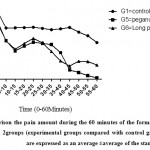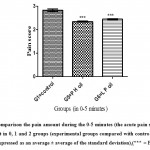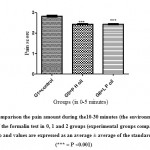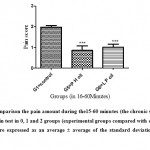Manuscript accepted on : 04 June 2016
Published online on: --
Peganum Harmala and Piper Longum Plant Rubbing Oil Effect on Pain in Small Male Mice
Shahin Moradi and Namdar Yousofvand.
Department of Biology, Faculty of Science, University of razi, Kermanshah, Iran
DOI : http://dx.doi.org/10.13005/bbra/2102
ABSTRACT: Peganum harmala and piper Longum medicinal herbs are used in traditional medicine to treat various diseases and to relieve tragic processes. The chemical composition of these two compounds is their analgesic agent. The purpose of this study was the Peganum harmala and piper Longum rubbing oil effect on pain in male mice by using formalin test. In this study, male mice were divided into three groups: control group, Peganum harmala rubbing oil group, piper Longum rubbing oil group. All groups were taken formalin test and data were analyzed by using Graphpad prism statistical software. In rubbing groups, Peganum harmala rubbing oil and the piper Longum rubbing oil, there was a significant difference compared with the control group (p<0.05). It seems that the reason of these two plants analgesic should be sought in their chemical composition. The chemical compositions of these two plants have analgesic effects.
KEYWORDS: Pain; Peganum harmala oil; Piper Longum oil; Formalin test; Mice
Download this article as:| Copy the following to cite this article: Moradi S, Yousofvand N. Peganum Harmala and Piper Longum Plant Rubbing Oil Effect on Pain in Small Male Mice. Biosci Biotech Res Asia 2016;13(2) |
| Copy the following to cite this URL: Moradi S, Yousofvand N. Peganum Harmala and Piper Longum Plant Rubbing Oil Effect on Pain in Small Male Mice. Biosci Biotech Res Asia 2016;13(2).Available from: https://www.biotech-asia.org/?p=14013 |
Introduction
The use of medicinal plants antiquity in Egypt, India, China, and Iran is more than all other countries and generally, the East Asian countries and Mesopotamia have a rich history of disease treatment with the medicinal plants (26). Wild rue or Persian rue (Peganum harmala) and Long pepper (piper Longum) are these medicinal plants. Peganum harmala is a plant that grows wild and belongs to Zygophylaceae family. This plant is found in eastern and northern Africa a lot. Since ancient times, it has been a claim that this plant is a medical and medicine plant and its seeds have a hallucinogenic and temperature reduction effect and properties (3,4). In addition, this plant is used traditionally in northern and eastern Africa as a period bringer and an abortion-inducing agent (6). Multiple reports in various articles show large pharmaceutical activity of Peganum harmala, including inhibiting the growth of MAO (Monoamine Oxidase) and anti-bacterial and anti-fungal activity (1). In addition, it was found that this plant is capable of aborting and is effective in the treatment of dermatitis (19), reducing the temperature (1) and cancer (1).
Four Alkaloid derivatives with Indole structure in Peganum harmala plant are known as Betacarboline. These alkaloids include Harmalyn, Norharmalyn, harmine and harmalol. Piper Longum is a plant of the pepper family that parts of it such as fruit will be traditionally used (27).
This plant does not grow in Iran, but growing in India evergreen forests will cultivate in Assam, Tamil Nadu and Andhra Pradesh (13).
This plant is effective in the treatment of many diseases, including cancer, inflammation, depression, diabetes, obesity, liver toxicity, stomach pain, bronchitis and Tumors (18). The chemical composition of Piper Longum is an essence percentage with pleasant smell, but with spicy and hot flavor. Much of this essence is composed of Flandren and Kennedy Nin and Chavysyn and piperine. Piper Longum spicy is because of Perrin. (28,29) . Therefore, this study was aimed to determine the analgesic effect of Peganum harmala and Piper Longum in order to achieve medications with analgesic effects and fewer side effects.
Materials and methods
Tested materials were the oil of Peganum harmala plant and the oil of Piper Longum plant. Studied animals were 42 white male rats breed NMR1 that was provided for the center of keeping and breeding animals of the Ilam Medical Sciences University. The animal keeping condition was under control in terms of temperature, humidity, light, nutrition and other environmental factors. The room temperature was 2 ± 22 ° C and its humidity was 30 to 40 percent. In terms of the day light amount, the rats were kept in a period of 12 hours darkness and 12 hours light. The light source was fluorescent lamp, its exposure time was from 6 am to 6 pm, and darkness was applied from 6 pm to 6 am the next morning. Animals’ nutrition was standard prepared food. After the compromise time, the male rats were randomly divided into 4 groups of 7 rats as follows:
Group zero– Blank group: they have received regular food and water for 35 days.
Group 1 – the experimental group 1: Peganum harmala oil with concentration of …., they have received the formalin test 6 hours ago.
Group 2- the experimental group 2: the extract of Piper Longum with concentration … they have received the formalin test 6 hours ago.
In the end, in order to get the pain score after formalin injection, the formalin test was performed over a period of 60 minutes and the behavioral results of animal pain responses were recorded. To evaluate the analgesic effects of a hydro alcoholic extract of two Peganum harmala and Piper Longum plants, the formalin test was used. Before the start of the formalin test, animals were brought to the test site to find necessary complying with the environment. Then, rats were contacted with two rubbing oil plants for about 6 hours and after that, about 0.02 ml formalin of 2.5 percent were injected into the palm of the animal’s right hand and immediately the animal was placed in the chamber test. In order to see better, the animal’s toe and mirror animal movements with an angle of 45 degrees were placed below it and in front of the observer. In this case, the animal showed a set of induced behaviors by formalin that they were given scores of 0, 1 and 2 based on Dennis and Dobison (5) method. The pain score was calculated at 60 minutes in5 minutes, 12 blocksand the average of pain score was calculated for each block according to the following formula (26).
Pain score = (0T0+1T1+2T2+3T3)/20
In this formula T0, T1, T2, T3 is the 15 seconds numbers that the animal showed 0,1,2 behaviors over a period of 5 minutes, respectively:
Score 0(zero) = The animal’s foot was naturally on the ground.
Score 1 = the animal’s foot was a little on the ground.
Score 2 = the animal’s foot is not on the ground and it is separate from it.
Score 3 = the animal was bitten or licked his foot.
Minutes 0-5 and 15-60, respectively, were considered as acute stages and chronic pain. Time of10-30 minutes in stimulus response of painful formalin test, was considered as the environment time or the pain changing phase (5). In order to data evaluation and the statistical analysis by using the Graphpad Prism 5 software and one-way statistical tests of ANOVA and its subsequent test of Tukey for comparing some groups and the statistical t-test for comparing two groups were used.
Research Findings
Comparing the amount of pain during the 60-minutes Formalin test in 0, 1, 2 groups which respectively were blank group, group in contact with Peganum harmala rubbing oil, group in contact with Piper Longum rubbing oil. By comparing the blank group with other groups, it was found that the groups in contact with oil rubbing of two plants have a significant difference with a control group in most of the test time (Figure 1).
G1 =control, G2 = in contact with Peganum harmala oil, G3 = in contact with Piper Longum oil
 |
Figure 1: Comparison the pain amount during the 60 minutes of the formalin test in the 0 group with 1 and 2 groups (experimental groups compared with control group and values are expressed as an average ±average of the standard deviation). |
Comparing the pain score during the 0-5 minutes (the acute pain stage) in Formalin test in 0, 1, 2 groups show that: both groups with Peganum harmala and Piper Longum rubbing oil contact have a significant difference with control group (* ** = P <0.001) (Figure 2).
PH =Peganum harmala
LP= Long peper
G1 =control, G2 = in contact with Peganum harmala oil, G3 = in contact with Piper Longum oil
 |
Figure 2: Comparison the pain amount during the 0-5 minutes (the acute pain stage) of the formalin test in 0, 1 and 2 groups (experimental groups compared with control group and values are expressed as an average ± average of the standard deviation).(*** = P <0.001) |
Comparing the pain score during the10-30 minutes (Environmental stage of pain) in Formalin test in 0, 1, 2 groups shows that: both groups with Peganum harmala and Piper Longum rubbing oil contact have a significant difference with control group(** = P <0.01 and *** = P <0.001)(Figure 3).
PH =Peganum harmala
LP= Long peper
G1 =control, G2 = in contact with Peganum harmala oil, G3 = in contact with Piper Longum oil
 |
Figure 3: Comparison the pain amount during the10-30 minutes (the environmental stage of pain) of the formalin test in 0, 1 and 2 groups (experimental groups compared with control group and values are expressed as an average ± average of the standard deviation).(*** = P <0.001) |
Comparing the pain score during the 15-60 minutes (the chronic pain stage) in Formalin test in 0, 1, 2 groups shows that: both groups with Peganum harmala and Piper Longum rubbing oil contact have a significant difference with control group (* = P <0.05 and ** = P <0.01 and *** = P <0.001) (Figure 4).
PH =Peganum harmala
LP= Long peper
G1 =control, G2 = in contact with Peganum harmala oil, G3 = in contact with Piper Longum oil
 |
Figure 4: Comparison the pain amount during the15-60 minutes (the chronic stage of pain) of the formalin test in 0, 1 and 2 groups (experimental groups compared with control group and values are expressed as an average ± average of the standard deviation). (*** = P <0.001) |
Discussion and Conclusion
In this research, the effect of Peganum harmala and Piper Longum rubbing oil analgesic was studied in rubbing form in male ratsby using formalin test. Results from this study showed that Peganum harmala and Piper Longum were reduced the pain in rats. We examine the effect of Peganum harmala analgesic at first.
The effect of Peganum harmala analgesic is due to its chemical composition which means BetaCarboline (Harmalyn, Norharmalyn, harmine and harmalol). Peganum harmala plant’s Beta-carboline was created analgesic with a dose-dependent manner in both early and late phases of the formalin test. The initial phase pain of the formalin test is the result of direct stimulation of pain receptors nerves. While the delayed phase is the result of the acute tissue injury and inflammatory process resulting from it (30). Medications that their analgesic effects have central mechanism, almost equally affected both phases of the formalin test. While the pain killer medications that act as environmental way, affect more in the delayed phase of the formalin test. This effect is included pain control resulted from prostaglandin production and releasing in the inflammatory process. (30).
One of the substances that have a fundamental role in creating pain and inflammation in the body are prostaglandins. (24). A Beta Carboline effect of Peganum harmala plant in both phases of formalin test is confirming their central effects. The analgesic effect of Peganum harmala is through inverse agonist effect on the surface of benzodiazepine receptors. The analgesic effect of Peganum harmala is done mediated through inverse agonist mechanisms on the surface of GABA receptors (30).
Beta-carboline control MAO Activity and increase the concentration of amines such as norepinephrine, serotonin and dopamine in the neural synapses that are involved in thoughts, emotions, memory and regulating some functions of the body (27). Some researchers have shown that beta-carboline will increase the concentrations of norepinephrine, serotonin and dopamine in different neurons synapses of rat’s brain with releasing of serotonin and catecholamine. Serotonin, which is secreted in the spinal nerves, can suppress pain (10). Piper Longum extract main components include; Flandren and Kennedy Nin and Chavisyn and piperine (13). In separate studies, the analgesic properties of these compounds are as follows:
Piperine is a purified alkaloid from black pepper that is also in Piper Longum. Recent studies showed on pharmacological effects of Piperine showed that Piperine has analgesic effects that these effects are caused from the impact on neurotransmitters such as catecholamine and serotonin.
Iperine, in the central nervous system was as a reduction of physical activity and anti-fever and a pain relief and has anti-inflammatory activity (32, 31). Flandren has anti-inflammatory and analgesic properties (19). It is also used in the perfumery industry due to its pleasing fragrance (28). In another study, the analgesic effect of the aerial parts of rosemary (Rosemarinus officinalis L) has been provenandg as chromatographic analysis showed that Flandren is one of rosemary extract components and probably has a role in the process of analgesia and pain relief, but no research has been done on its mechanism of action (15).
As a result, according to the above discussion, it is likely that the analgesic medicinal effects of hydro alcoholic Piper Longum plant extract are depending on its composition which means Flandren, KennedyNin, Chavisyn and piperine especially Flandren and piperine. These compounds together have caused a significant decreasing of pain score in receiving the extract group of all phases of the formalin test. Combining the two extracts was reduced the pain. It was expected that its analgesic effect will be stronger than either of the extracts alone, but the result was not like that and its analgesic effect was at the extract alone.
Acknowledgements
This work is funded by Razi university research grant for MSc thesis work.
References
- Abdel-Fattah, A.M., Matsumoto, K., Watanabe, H., 2000. AntinociceptiveEffects of Nigella sativa oil and its major component, thymoquinone, inmice. European Journal of Pharmacology 400, 89–97.
- Achilles A.U, Haase W and Rheinlander H . (2001). Biochemical and characterization of nociceptor. Antimicrobial Chemotherapy, 693: 243-244.
- Bahri L. Peganum harmala L: a poisonous Plant of North Africa. Vet Hum Toxicol 1991; 33(3): 276-277.
- Bellakhdar, J., 1997. La pharmacopeia marocaine traditionally. Medicine arabe Ancientet saviorspopularizes. Ibis Press, Paris, pp. 529–530.
- Dubuisson D, Dennis SJ ,1977. The formalin test: A quantitative study of the analgesic effects of morphine, meperidine, and brain stem stimulation in rats and cats. Pain; 4: 161-74.
- El-Bahri, L., Chemli, R., 1991. Peganum harmala : a poisonous plant of North Africa. Veterinary and Human Toxicology 33, 276–277.
- Farouk L, Laroubi A, Aboufatima R, Benharref A, Chait (2007) . Evaluation of the analgesic effect of alkaloid extract of Peganum harmala L.: Possible mechanisms involved , 455-449,
- Ganong , W .( 2010). Review of medical Phisiology.23th ed
- Guyton, A and Hall,G. (2006).Textbook of medical Physiology. 11th Chehr publication
- Hirsch JA,cohen Sp,Dattas, Singh Y,Manchikaati L, (2009)Compressive review of epidemiology,scope, and impact of spinal pain; pain Physician: 12(4) ;35-70
- Kirtikar, K.R., Basu, B.D., 1935. Indian Medicinal Plants, vol. 1., 2nd ed. Lalit Mohan Basu, Allahabad, p. 457
- Kuenzi FM, Dale N. Effect of capsaicin and Analogues on potassium and calcium currents and vanilloid receptors in xenopus embryo spinal neurons. Br J Pharmacology. 1996; 119(1): 81-90.
- Kumar S*, Kamboj J, Suman, Sharma SH .(2001) Overview for Various Aspects of the HealthBenefits of Piper Longum Fruit;4(2):134−140
- Mayer JM, Haldeman S,Tricco AC,Dagenais S.(2007);Management of chronic low blak pain in active individuals,Curr Sports Med Rep. ;9(1):60-66
- Martinez AL, Gonzlez-Trujano ME, Pellicer F, Lopez-Munoz FJ, Narrete A . (2009) . Antinociceptive effect and GC/MS analysis of Rosmarinus officinalis L. essential oil from its aerial parts, Plantar Med. 75 (5): 508 – 11.
- Nelson, D.L., Herbet, A., Petillot, Y., Pichat, L., Glowinski, J., Hamon, M., 1979. [3H] Harmaline as a specific ligand of MAOA-I. Properties of the active site of MAOA from rat and bovine brains. Journal of Neurochemistry 32, 1817–1827.
- Rainsville P. Brain mechanisms of pain affect and pain modulation. Curr Opine Neurobiology 2002; 12(2): 195-204.
- Rastogi RP, Malhotra BN. Compendium of Indian Medicinal Plants. CDRI, Luck now and New Delhi, India: Nisc 1993: 504−857.
- Saeed, S.A., Farnaz, S., Simjee, R.U., Malik, A., 1993. Triterpenes and bsitosterol from piper betel: isolation, antiplatelet and anti-inflammatory effects. Biochemical Society Transactions 21, 462 S.
- Sigg EB, Gyermek L, Hill RT, Yen HC. Neuropharmacology of some hormone derivatives. Arch Int Pharmacodyn Ther. 1964; 149(2):164-80.
- Thiebot MH, Soubrie P, Sanger D. Anxiogenic properties of beta-CCE and FG 7142: a review of Promises and pitfalls. Psychopharmacology (Berl). 1988; 94(4):452-63.
- Urben , Peter . (2007) . Bretherick’s Handobook of Reactive Chemical Hazards 1 (7 ed.). Butterworth-Heinemann. p. 1154.
- Velisek, J., Z. Svobodova and V. Piackova, 2005, Effects of clove oil anesthesia on rainbow trout(Oncorhynchus mykiss). Acta Vet. Brno., 74 : 139-146
- Williams, L.A., 2000. Neuroscience and Physiology. Bull. Press, New York, USA, 578p
- Zargari A . (1996) . medicine plants, sixth edition, vol2,Tehran University Publication, pp: 528 –
- Zarifkar A, Skandaryan H, Mokhtari M ,2003. An evaluation on antinociceptive effects of eugenol by formalin test in rats. Journal of Dentistry. Tehran University of medical sciences; 16; 1: 61-67
- Farzin D and Dr. Mansouri S N. (2005) comparing the effects of Harman, norharmane and Harmine antidepressants in rat, Journal of Gorgan University of Medical Sciences, Vol. VI, No. 14, pp. 1 to 9
- Zargari, Ali, 1993, Volume Four, Tehran University Press, Fifth Edition, pp. 641-639
- Hussein Myrhydar. (2007), Plant Sciences, Volume III, Islamic culture, pp. 75-72
- Farzin D, Kalantari P, Zayer H. (2013) the Harman, norharmane and harmine effect on induced pain by hot plate and formalin test in rat, Mazandaran University of Medical Sciences journal,22th period ,no 87
- Moghaddamnia A A, Hosseini M L, Jannati J M. (2005). Study of Piperine analgesic effects by hot-plate and formalin test in rat. Journal of Gorgan University of Medical Sciences, 2005;. 6, (13)
- Kazemi M. T, Pour-Nasrolah M, Rezaei M.M, Jorsaraei S.G.A, Maliji G Kazemi, S., Zabihi A, Pour Amir M, Moghaddamnia A A . (2013), Piperine effect on biochemical parameters caused by liver toxicity Astamynofen In white big rat, 14, pp. 14-7

This work is licensed under a Creative Commons Attribution 4.0 International License.





